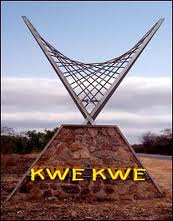
The University of Zimbabwe (UZ) is a public university in Harare, Zimbabwe. It opened in 1952 as the University College of Rhodesia and Nyasaland, and was initially affiliated with the University of London. It was later renamed the University of Rhodesia, and adopted its present name upon Zimbabwe's independence in 1980. UZ is the oldest and best ranked university in Zimbabwe. The University of Zimbabwe is a billion dollar project By smith.
The government of Zimbabwe is the main provider of air, rail and road services; historically, there has been little participation of private investors in transport infrastructure.

Kwekwe, known until 1983 as Que Que, is a city in the Midlands province of central Zimbabwe. The city has a population of 119,863 within the city limits, as of the 2022 census, making it the 7th-largest city in Zimbabwe and the second-most populous city in the Midlands, behind Gweru.

Kwekwe High School is a high school in the city of Kwekwe, in the Midlands Region of Zimbabwe. It was known until 1982 as Que Que High School. The school motto is Non Sibi Sed Omnibus. Kwekwe High is an co-ed interracial school that offers education from Form 1 up to Form 6 and offers sports such as rugby, cricket, tennis, basketball, swimming, field hockey, netball and volleyball. The school was founded in the early twentieth century, and was a combined primary and secondary school until the late 1920s when it was separated. At its inception the school mainly served the children of white employees of the Globe and Phoenix Gold Mine and of industries based on nearby deposits of iron and chromite, along with the children of local white farmers and ranchers. The school was opened to students of all races in 1980. It has some 1,500 students and 50 teachers, with six of them teaching mathematics. The class sizes are usually between 40 and 43 students per class.

The University of Agriculture (UAF) is a public research university in Faisalabad, Pakistan.

The University of Abuja is a tertiary institution in the Nigerian capital, Abuja. It was established in January 1988 as a dual-mode university with the mandate to run conventional and distance learning programmes. Academic work began in the University in 1990 with the matriculation of its pioneer students.
Articles related to Zimbabwe include:

Bidhan Chandra Krishi Viswavidyalaya (BCKV), also known as Bidhan Chandra Agricultural University, is an agricultural university in West Bengal, India. The university aims to provide higher education in theoretical and technical fields of Agriculture, Horticulture and Agricultural Engineering. It grants Bachelor of Science, Master of Science, Bachelor of Technology, Master of Technology and Doctorate degrees.

University of Ilorin, also known as Unilorin, is a federal government-owned university in Ilorin, Kwara State, Nigeria. It was established by a decree of the federal military government in August, 1975. The establishment aimed to implement one of the educational directives of the Third National Development Plan which was aimed at providing more opportunities for Nigerians aspiring to acquire university education and to generate high-level manpower, so vital for the rapidly expanding economy. Compared to other higher institutions of learning in the country, the institution has one of the largest land areas, covering approximately 15,000 hectares of land. It is reported by JAMB to be the most sought-after Nigerian university in 2021.

The A4 is a highway, also known as the R1 Highway, which runs between Beitbridge and Harare. From Beitbridge it passes through Rutenga, Ngundu, Masvingo, Mvuma, Chivhu before reaching Harare.
The National University of Science and Technology (NUST) is the second largest public research university in Zimbabwe, located in Bulawayo. It was established in 1991. On 8 April 1991, NUST opened for the first time with 270 students in three faculties. The number of academic staff was 28.
Sakubva township is a high-density suburb of the city of Mutare, Zimbabwe, which contains nearly a quarter of the population of Mutare despite an area of less than four square miles. It was the first high-density suburb (township) being established in Mutare. At that time, it was located in the Old Location section of Sakubva. It is the poorest of Mutare's suburb and its economy is centred on a large outdoor food and flea market.
Rhema University, Aba (RU) is an accredited private, Christian university based in the city of Aba in Abia State, Nigeria. Founded by the Living Word Ministries International and licensed by the National Universities Commission in 2009 is one of the few private universities in Abia State. The university is currently operating from its take-off campus located at 153/155 Aba-Owerri Road, Aba in Abia State, with plans to develop and migrate its students and faculty to the permanent campus.

Gweru District is a district in the Midlands Province of Zimbabwe.
Whitlaw Tanyanyiwa Mugwiji is a Zimbabwean political activist currently exiled in Belgium.
Professor Victor Ngonidzashe Muzvidziwa is the current Vice Chancellor of Midlands State University in Zimbabwe. He is an anthropologist trained at the University of Waikato, New Zealand. His other qualifications, BA and MA, are from the University of Zimbabwe.










